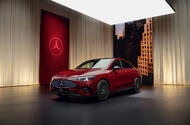The new Mercedes-Benz CLA is generating buzz as it steps into the electric vehicle (EV) arena, boasting an impressive 492-mile range. However, there’s a catch that potential buyers should be aware of: this sleek EV won’t be able to utilize 400V DC chargers, which are quite common across the UK and Europe. So, what does this mean for drivers looking to make the switch to electric?
Understanding the Charging Limitations
The third-generation CLA is built on Mercedes’ new MMA electric car platform, but it lacks a crucial component—a DC-to-DC voltage booster. This absence means that the CLA can only fast-charge at stations that supply 800 volts. While this might sound high-tech and efficient, it also limits compatibility with many existing charging stations, particularly older 50kW units and the majority of Tesla Superchargers currently in operation.
In the UK alone, there are over 14,000 public charge points capable of 50kW charging or faster, according to Zap-Map. However, the majority of these are 400V chargers, which can deliver up to 250kW. The newer 800V charging stations, while capable of charging at speeds nearly double that, are still not as widespread. This discrepancy raises questions about the practicality of owning a CLA EV, especially for those who rely on public charging infrastructure.
Cost-Saving Decisions and Consumer Impact
Mercedes has indicated that the decision to omit the 400V DC converter is likely a cost-saving measure. The thinking seems to be that most customers will primarily charge their vehicles at home using an AC connection. In this scenario, 400V AC is converted into 800V DC internally for battery use, which may make the omission less impactful for home chargers. However, for those who frequently use public charging stations, this limitation could pose significant inconveniences.
A spokesperson for Mercedes mentioned that the share of 800V DC fast-charging stations is on the rise, and drivers will be directed to compatible stations via the navigation system. This real-time update feature is a nice touch, but it doesn’t fully address the concern of limited charging options for CLA owners, especially in regions where 400V chargers are still prevalent.
Comparing Approaches: How Rivals Handle Charging
Interestingly, other manufacturers have taken a different route. Brands like Hyundai and Kia have equipped their E-GMP-platform EVs, such as the Ioniq 5 and EV6, with internal voltage boosters. This allows for seamless charging from both 400V and 800V stations, providing greater flexibility for drivers. On the other hand, Porsche and Audi have implemented a split-pack battery strategy in their PPE-platform EVs, allowing for charging at 400V, albeit at reduced speeds.
Mercedes’ choice not to include similar solutions in the CLA raises questions about their strategy in a competitive market. While the company is focusing on the future of charging infrastructure, the current landscape still includes many 400V chargers, especially in countries like Norway, where EV charging networks were established earlier.
What’s Next for the CLA EV?
There are reports suggesting that the CLA EV sold in Norway might come equipped with the DC-to-DC booster, but it’s unclear if this feature will extend to models in other European markets. Interestingly, the online configurators for Mercedes in Belgium and the Netherlands make no mention of the charging limitation, which could lead to confusion for potential buyers.
As the automotive landscape continues to evolve, the CLA’s charging capabilities will be a critical factor for consumers weighing their options. While the promise of a long range is enticing, the practicality of charging infrastructure cannot be overlooked.
The big takeaway? The Mercedes-Benz CLA EV isn’t just about sleek design and impressive range; it’s also about navigating the complexities of charging options. If you’re considering making the switch to electric, it’s worth evaluating your charging habits and the availability of compatible stations in your area. Start with one change this week, and you’ll likely spot the difference by month’s end.

